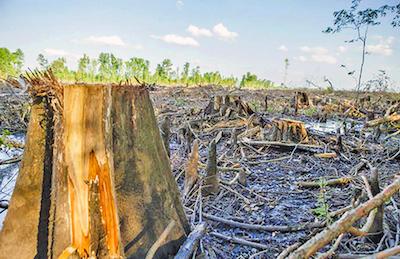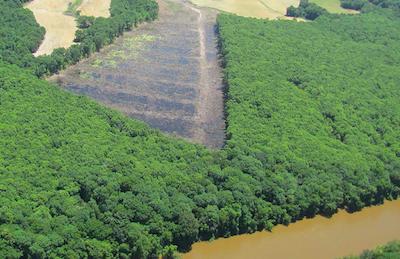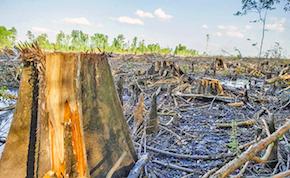A growing industry that’s harvesting “woody biomass” from forests for energy generation could gain a toehold soon in the Chesapeake Bay watershed. Like virtually every other form of energy, it’s also generating intense debate about its environmental impact.

Enviva says it takes only “junk” wood from forests, but that includes bottomland hardwood forests that take many decades to regrow. (Courtesy of Dogwood Alliance May 2015)
Biomass from trees is already used to generate a small amount of power in the United States; wood chips generate electricity at several small plants owned by Dominion, the Virginia-based energy company. (The term “biomass” generally refers to any plant material used for fuel. Woody biomass, as the name suggests, is made from trees.)
The big demand for pellets made from woody biomass, though, comes from utilities in Europe and the United Kingdom that are trying to reduce their reliance on fossil fuels. This is driving the harvesting of low-value trees and “slash” (debris left by logging) in the Southeastern United States, from just south of the Bay watershed to the state of Mississippi.
A spokesman for the nation’s largest wood pellet manufacturer, Enviva Partners LP, says that the company has no plans to move farther north, but added that “it’s not outside the realm of possibility.”
Based in Bethesda, Md., Enviva has a pellet manufacturing plant in Franklin, Va., just outside the Bay watershed. Within the watershed it has two storage domes at a deepwater port in Chesapeake, Va., at the mouth of Paradise Creek on the Elizabeth River. The company is planning to build another pellet plant in Virginia, south and west of the Franklin plant, says Enviva spokesman Kent Jenkins.
Three Dominion-owned power stations in Southside Virginia and one just south of the North Carolina border together burn 100 tractor-trailer loads daily of wood chips and other biomass taken from nearby forests, says Ernie Reed, president of Wild Virginia, a nonprofit advocacy group.
But demand in Europe dwarfs the local market for woody biomass, Reed said, and much of what’s produced in the United States gets exported. About 5.5 million tons of wood pellets from Southeastern U.S. forests will be shipped overseas this year for energy generation in the European Union, according to David Carr, a lawyer with the Southern Environmental Law Center.
Power companies there are converting coal-fired power plants to burn wood pellets to meet European Union renewable energy goals. One-fifth of their electricity must come from renewable resources by 2020 and even more by 2030. Some countries are providing subsidies to support the conversion.

The dark color in this cut is standing water in a wetland adjacent to the Roanoke River. Environmentalists say this North Carolina cut included trees more than 100 years old, with some and possibly most going to an Enviva pellet mill. (Southern Environmental Law Center 2013)
But several U.S. and European environmental groups are lobbying the European Union to take woody biomass out of its renewable energy goals, Carr says.
Forests are widely recognized as the best land use for sequestering climate-altering carbon dioxide and for preventing polluted runoff of nutrients and sediment into waterways.
According to the environmental law center, using Enviva’s mainly hardwood pellets from North Carolina and Virginia to generate power in the United Kingdom releases 2.5 times as much carbon dioxide into the atmosphere as would burning coal.
Carr contends that using wood pellets to generate electricity is bad for the Earth’s climate. Trees sequester or absorb carbon from the atmosphere as they grow, so regenerating forests — either naturally or through planting seedlings — can offset the impact of logging them. But trees grow slowly, and Carr contended that the carbon dioxide released by burning woody biomass from mature forests won’t be recaptured for many decades.
Nathanael Greene, renewable energy director at the Natural Resources Defense Council, concurrs with Carr’s assessment, but adds that he supports the collection and use of woody biomass for one purpose: bio-jet fuel. But the deployment of any other green technology capable of powering commercial aircraft is at least 30 years away, Greene says.
The industrial wood pellet industry maintains that when all aspects of preserving working forests and replanting logged-over tracts are taken into account, generating electrical power from wood pellets produces much lower greenhouse gas emissions than coal.
Seth Ginther, executive director of the U.S. Industrial Pellet Association, insists that the industry is “actually expanding forest cover, among other things, by giving forest owners a financial incentive to maintain working forests and stay in business — rather than [cutting them down] and selling out to developers or other non-forest land users.”
And, Ginther notes, “One of the biggest threats to the Chesapeake Bay watershed is the conversion of forest areas to non-forest uses, including urban sprawl and real estate development.”
The National Renewable Energy Laboratory, an arm of the U.S. Department of Energy, sides with the industry in part, saying that using biomass for energy has the potential to greatly reduce greenhouse gas emissions.
Burning fossil fuels like coal and oil releases carbon dioxide captured millions of years ago; creating essentially new greenhouse gas. In contrast, the laboratory says on its website, burning biomass emits carbon dioxide that is in a matter of years offset by the regrowth of forests cut to produce it.
But in an added observation that seems to buttress critics of the industry, the laboratory says that “recent studies have found that clearing forests to grow biomass results in a carbon penalty that takes decades to recoup, so it is best if biomass is grown on previously cleared land, such as under-utilized farm land.”
The analysis does not address the impact of taking biomass from the debris left on the ground after a forest tract has been logged for timber. Nor does the NREL examine the question of whether the extra income forest owners receive from biomass collection leads them to stay in the business, instead of selling out to developers or farmers.
One peer-reviewed study of the issue cited by the pellet industry suggests that hardwood forest owners will switch to raising softwood pines, which regrow much faster, in as little as 20 years in warm climates.
Another study by the U.K. Department of Energy and Climate Change offered several scenarios, including a benign one based on an expansion of forest cover in the Southeastern United States. But the adverse scenario found that the use of Southern U.S. wood pellets to fuel U.K. power plants would have life-cycle greenhouse gas impacts worse than coal.
Carr says the pellet industry has no qualms about using wood from clear-cut forest parcels adjacent to water bodies, pointing to an SELC photo showing a denuded forest parcel adjacent to the Roanoke River.
Enviva spokesman Jenkins says the photo has been “recycled by environmental groups for years” and does not reflect Enviva work. Wood pellet manufacturing facilities generally tap forests within a radius of 100 miles of each plant and sometimes more, Jenkins says — though Enviva is considering using rail to ship biomass from hundreds of miles west to the Eastern Seaboard.
Just what makes up that biomass has been one of the hotly contested issues, with environmentalists asserting that industry is responsible for the clear-cutting of forests, including “low-land” forests.
Jenkins concedes that Enviva accepts woody biomass from lowland parcels — wetlands where trees cannot be commercially grown. But he says that trees will still regrow naturally in lowlands. In any case, Jenkins says, the company uses only what’s left over from forest tracts harvested for telephone poles, lumber, wood floors, furniture and the like. More than 80 percent of a parcel’s value is from trees sold for the “high value” uses.
The low-value wood can include whole pulpwood trees traditionally used by the paper industry and whole hardwood trees that are too narrow, misshapen or partially diseased or rotten, the company spokesman says. Enviva also uses “slash” from high-value timber, Jenkins says, such as tree tops and branches that cannot easily be debarked.
Forests are the most effective land cover for soaking up rain and keeping nutrients and sediment out of water bodies. The 2014 Bay Watershed Agreement seeks to promote the expansion of forest cover in the watershed. If the industry moves into the Bay watershed, it could badly set back efforts to expand forest cover, Carr predicts.
But two other environmental advocates suggest that as long as good forest management practices are followed, the wood pellet industry would not set back Bay restoration efforts. “If the manufacturers follow best silviculture practices they can avoid significant damage to the environment,” says Kenny Fletcher, spokesman for the Virginia office of the Chesapeake Bay Foundation.
By Jeff Day, Bay Journal News Service
Jeff Day covered government policy developments for more than 20 years at Bloomberg BNA, including Chesapeake Bay restoration efforts since 2009.



William Strauss says
Please ask Jeff Day to download and read a few of our white papers on the topic of carbon accounting and the use of woody biomass for energy.
In particular please read a recent critique of a Washington Post story “Washington Post and 65 Experts Are Wrong about Wood Pellets” which carefully explains the logic and contains data on the uses of forest products (like pulp and paper, lumber, and wood pellets).
All papers are at http://www.FutureMetrics.com and are free to download.
Best regards, Bill Strauss, PhD, President, FutureMetrics